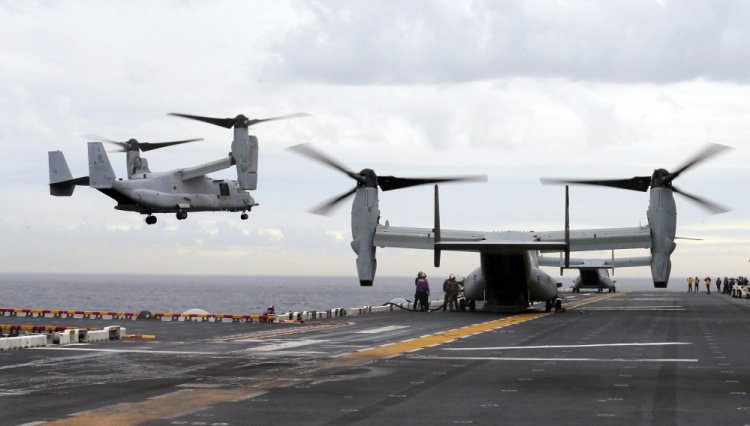An expert on military aircraft says that although the V-22 Osprey had a very troubled development period, the tilt-rotor aircraft has a good safety record compared with other military aircraft since becoming operational in 2007.
“Compared to the number of helicopters lost, there have been relatively few Osprey accidents,” said Richard Whittle.
Whittle is a journalist and the author of several books, including “Dream Machine,” which details the 25-year, $22 billion development period of the Osprey that saw four crashes causing 30 deaths.
The Osprey, which is used to transport troops and equipment, can reach speeds of 280 mph, while helicopters can reach about 120 mph, Whittle said. The Osprey has been used by the U.S. Air Force in nighttime raids in Afghanistan and in Iraq.
“It had an ugly-duckling development, but really for the past decade it has been a bit of swan,” Whittle said Sunday.
Three Marines, including a native of Maine, were killed Saturday when their Osprey crashed while trying to land on a Navy ship off the coast of Australia.
Since 2001, there have been about 440 or more U.S. military helicopter crashes with more than 650 people killed, Whittle said. But there have been less than a dozen Osprey crashes and about the same number of deaths.
Whittle said military aviation is a dangerous undertaking.
“Landing on ships is a practice that is fraught with risks,” he said. “It is done every day, not just by the Marines, but the Navy and other services. There are pilots who are very skilled at it, but it is never without risk.”
The speed and range of the V-22 Osprey – called the MV-22 Osprey by the Marines – allows the Marines to operate with fewer amphibious landing ships and expeditionary units to operate farther away from each other, Whittle said.
He said it has been hard for the Osprey to shed the reputation it got during its shaky development period. He said the aircraft continues to have a strong contingent of critics.
“The Osprey has its true believers and its die-hard foes. A lot of the time the facts do not seem to matter in the debate,” he said.
That has caused unnecessary worry among the relatives of those who are assigned to the Osprey, he said.
“They shouldn’t be worried. It is really a safe military aircraft,” he said.
It isn’t clear how many of the aircraft are in service. The Pentagon initially ordered 458 Ospreys, with 360 slated to go to the Marines at a cost of roughly $70 million apiece.
Send questions/comments to the editors.




Success. Please wait for the page to reload. If the page does not reload within 5 seconds, please refresh the page.
Enter your email and password to access comments.
Hi, to comment on stories you must . This profile is in addition to your subscription and website login.
Already have a commenting profile? .
Invalid username/password.
Please check your email to confirm and complete your registration.
Only subscribers are eligible to post comments. Please subscribe or login first for digital access. Here’s why.
Use the form below to reset your password. When you've submitted your account email, we will send an email with a reset code.